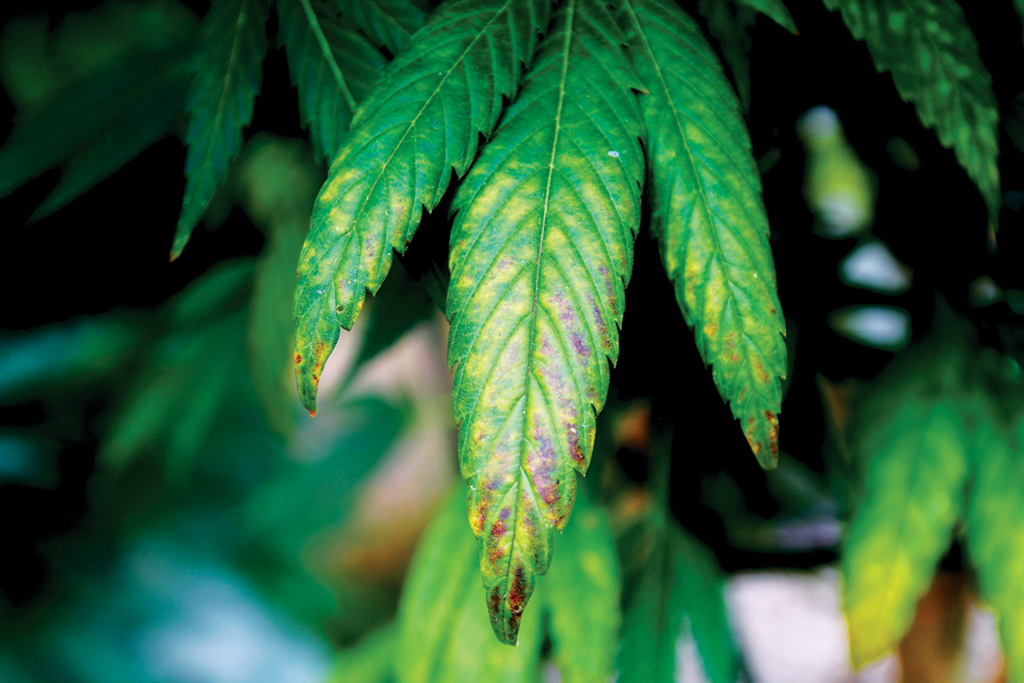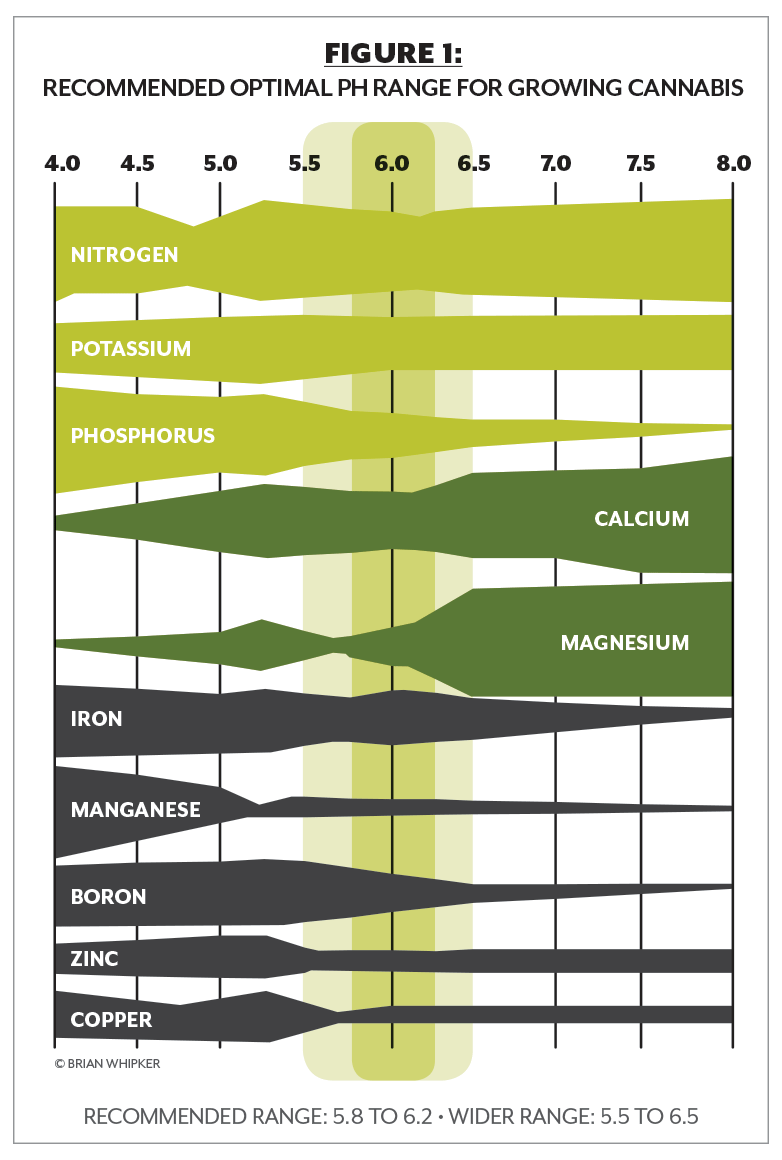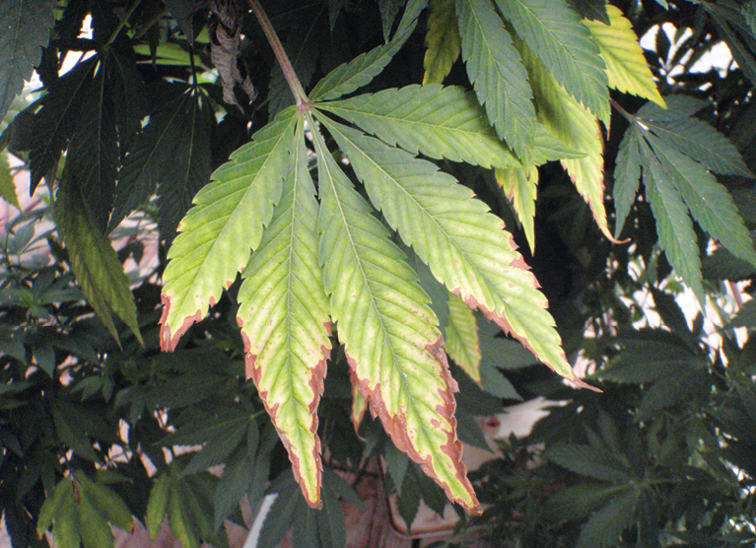

Much of the indoor production of Cannabis sativa relies upon a hydroponic (non-soil) growing system. This means that a full complement of nutrients in a balanced formulation must be provided to the plants. Other factors, such as pH and electrical conductivity (EC), should also be tracked to ensure the plants have adequate nutrient availability.
While managing all these factors may seem daunting, commercial floriculture production has been executing this level of management successfully for the past 40 years. The challenge for cannabis growers is the lack of scientific research to back up production recommendations. With cannabis production legalized in many states and in Canada, research into sound nutrient practices is now possible. These 10 tips for plant nutrition are built on the pillars of the ongoing research studies we are conducting at North Carolina State University (NCSU), observations made while working with cannabis and floriculture growers, and years of greenhouse production research. These recommendations are the foundation of nutrition in controlled-environment-grown plants in a soilless substrate, and many of the tips apply to other types of hydroponic growing, too.
1. Invest in a Combination pH/EC Meter
Two parameters—pH and electrical conductivity—hold the key to your crop’s nutritional status. The substrate pH affects nutrient availability (see Fig. 1 below). If the pH is too low (more acid), micronutrients-nutrient availability will increase and, in many cases, will accumulate to toxic levels (micronutrients-nutrient toxicities) in the plant. Iron (Fe) and manganese (Mn) are the two main elements that will reach toxic levels in plants at low pH levels.
If the pH becomes too high (more alkaline), micronutrients-nutrient deficiency becomes the concern. The primary elements that risk being deficient are Fe, Mn, and boron (B). When substrate pH is greater than 6.5, these elements’ chemical interactions in the fertilizer solution are altered, and they can become “tied up” in the solution—making them less available to the plant. (See tip No. 6 for an explanation of EC.)
A wide assortment of meters are available on the market. Some growers will purchase separate pH and EC meters. For the past 20 years, NCSU has been recommending combination pH and EC meters. It is far easier to conduct in-house testing with only one piece of equipment. Most growers we work with purchase a unit that costs less than $200. Two widely used units growers purchase are the Hanna 9813-6 combination meter or the Milwaukee Instruments MW802. Both are low cost and provide invaluable information about your crop’s nutrient status.

2. Begin an In-House Nutrient Monitoring Program
After purchasing a combination pH and EC meter, start using it. The majority of the commercial floriculture greenhouse industry relies upon the non-destructive PourThru monitoring method to test pH and EC. In this method, a small amount of clear water is poured into the top of the container to push the nutrient solution to the bottom of the pot. Growers can then collect and test that leachate.
Weekly or biweekly sampling is the key to ensuring your pH and EC levels are on track. While cannabis-specific recommendations have not been published, guidelines for sampling can be found at the nutrient-monitoring website: fertdirtandsquirt.com.
3. Test Your Water Quality
It is always good to know what you are adding to your crop from your irrigation supply. A water test will provide you with a baseline set of numbers about both macronutrients and micronutrients supplied by your irrigation water. Labs also test for the pH, EC and alkalinity (carbonate and bicarbonate) levels. This information will help you formulate a fertilizer program so that adequate nutrient levels are provided to your plants. It can also be used to help you potentially avoid toxic conditions caused by adding too much of a specific element already supplied in sufficient quantities by your irrigation water.

4. Target the Substrate pH Between 5.5 and 6.5
The recommended substrate pH for cannabis growing varies widely. A recommended substrate pH of 6.0 to 6.5 is often provided as the standard. During visits to commercial greenhouses growing cannabis, we have seen low pH ranges between 4 and 5, or higher levels slightly greater than 7. Plants grown at the lower pH appear to have normal growth and lack the toxicity symptomology of lower leaf blacking or bronzing that is typically observed with other greenhouse species at this low pH. We have rarely seen interveinal chlorosis of the upper (youngest) leaves on cannabis plants, a common symptom of greenhouse crops grown at high pH. The preliminary results of a follow-up research study at NCSU that focused on higher pH levels show that iron chlorosis did appear on plants grown at pH 7.9.
Based on the preliminary results of research conducted at NCSU, data implies that vegetative stock plants of cannabis have a wide substrate pH range in which the plants will optimally grow. That range appears to be as wide as pH 5.0 to 7.0. Based on experiences with other species, a narrower range of 5.5 to 6.5 may be more appropriate to target with cannabis, as this will allow growers to make adjustments as pH approaches the ends of the targeted range. For growers, adapting these pH values to a monitoring system implies that the safe pH zone to target would be a narrower 5.8 to 6.2. (see Fig. 1 above). If the pH drops below 5.8, corrective procedures should begin to slightly increase the pH back into the 5.8-to-6.2 range. On the opposite end of the spectrum, if the substrate pH increases to above 6.2, corrective procedures should begin to slightly decrease the pH back into the 5.8-to-6.2 range. By monitoring the substrate pH over time, you can assure that the plants are within the optimal range.
5. Target Fertilization Rates for Stages of Plant Development
Similar to humans over their life spans, plants’ nutrient demands change over time. Young plants, like babies, need less food. As plants grow and bulk up, like teenagers, the amount of food they need increases. When the photoperiod changes and flower formation begins, the plants, at that point, have set the number of leaf nodes and flower nodes. This terminal inflorescence determines how much more growth will occur. The amount of vegetative mass that the plant adds during this growth stage is less, and energy and resources go to the developing buds. With this vegetative slowdown, the nutrient demands change. Given the scenario of plant growth, it comes as no surprise that nutrient delivery needs to be customized to meet the changing demands of the crop throughout its different growth stages. For guidelines about fertility levels based on plant development stage, see Fig. 2.
6. Match Target EC Levels to Stage of Plant Development
The EC is an indirect measure of the fertilizer salts contained in the substrate. By starting an in-house nutrient monitoring program as suggested in tip No. 2, you can measure the EC to ensure that sufficient levels of fertility are available to the plants. Fig. 3 contains recommended EC levels as measured by the PourThru method.
If the levels are lower than the recommended range, this implies the plant’s nutrient demand is higher than what is being supplied. In this case, you should increase the fertilizer rate. If the EC is increasing over time, this indicates the fertilizer is accumulating in the pot and the rate is higher than the demand by the plant. Dialing back the fertilizer rate will help avoid the accumulation of toxic levels of fertilizers and help save money by not wasting fertilizer solution.

7. Provide a Balanced and Complete Fertilizer Program
After obtaining your water test, you can start building a fertilizer program. Soilless substrates provide little nutrients. You must provide them; however, those rates will vary depending on your water test, fertility program and plant growth stage. A standard fertilization practice used with floriculture production is to provide the following ratios: 10 parts Nitrogen (N); 1 to 2 parts Phosphorus (P); 10 parts Potassium (K); 5 parts Calcium (Ca); 2 to 3 parts Magnesium (Mg); 1 to 3 parts Sulfur (S), plus a complete set of micronutrients if needed (based on your irrigation water report). The nitrogen should be mainly in the nitrate form (see tip No. 8), and supplemental Mg may be needed (see tip No. 10).
8. Rely on Nitrate-Based Nitrogen
Nitrogen form significantly influences plant growth. The three primary forms of nitrogen provided to plants are nitrate- nitrogen (NO3-N), ammoniacal-nitrogen (NH4-N) and urea-nitrogen. Nitrate- nitrogen provides more compact and controlled growth. More extensive leaf and stem growth occurs with ammoniacal-nitrogen and urea-nitrogen. In general, to avoid excessive stretching and oversized leaves, more than 60 percent of the nitrogen provided to plants should be in the nitrate-nitrogen form. Ideally, it should be 70 percent to 80 percent. This will provide a moderate growth response with cannabis plants and avoid overly large plants.
9. Manage Phosphorus in the 15-ppm to 25-ppm Range
Phosphorus (P) is an essential element for plant growth. It plays a critical part in energy transfer within the plant, flowering enhancement and stem elongation. At NCSU, we have been focusing our research on the role of P in plant growth in greenhouse floriculture production. For most floriculture species, growth is maximized when 10 ppm to 15 ppm P is provided. Levels below that (~5 ppm to 10 ppm) are useful for controlling excessive plant growth. This may be a production option for cannabis growers who want to manage excessive plant growth, as no plant growth regulators (PGRs) are registered for cannabis, and two of the most common PGRs, paclobutrazol and daminozide, may be part of the chemical contamination screening program and would make your cannabis unsellable. Providing no P, or too little, will lead to a P deficiency, in which plants will be stunted and flower production will be negatively impacted.
Optimal P levels have not been determined for cannabis through scientific studies. As stated, most floriculture species have maximum growth with 10 ppm to 15 ppm P. Levels above that typically are not beneficial, and you are wasting your money. But with cannabis’s response to P fertilization currently uncertain, a more generous amount of 15 ppm to 25 ppm P is suggested as the target range at this time.
10. Provide Supplemental Magnesium (Mg)
Cannabis plants often develop interveinal chlorosis (yellowing) on the lower leaves (Fig. 4). Over time, necrotic (brown) spotting also occurs (Fig. 5). These symptoms are associated with a magnesium (Mg) deficiency. Symptoms have been observed in greenhouses in locations without Mg in the irrigation water supply, as one would expect, but it is not uncommon to also observe symptomology in areas with moderate levels of Mg in the water. This leads to the conclusion that cannabis, similar to tomatoes and poinsettias, has a higher demand for Mg than most plant species.
Fixing a Mg deficiency is easy. Epsom salts (magnesium sulfate) can be applied at the rate of 2 pounds per 100 gallons of water (2.4 kg/1,000L). Apply this solution as a 10-percent flow-through leaching irrigation. This will stop the progression of symptoms and provide adequate Mg to the plant, but will not reverse any interveinal leaf chlorosis or necrotic spotting. For areas that lack sufficient Mg in their irrigation water and Mg is not part of the regular fertilization program (e.g., 20-10-20 pre-mixes do not contain Mg), monthly applications of Epsom salts at the rate of 1 pound per 100 gallons of water (1.2 kg/1,000L) is the common production practice to green up plants and avoid deficiencies.

These 10 tips help form your basic building blocks of plant nutrition to avoid problems and ensure your plants are on track for healthy growth. Knowing the facts is the only way to build a fundamentally sound fertility plan.

Explore the December 2018 Issue
Check out more from this issue and find your next story to read.
Latest from Cannabis Business Times
- Navigating Cultivation Room Design: Optimization vs. Maximization
- Verano Opens 18th Medical Cannabis Dispensary in Pennsylvania
- Hundreds Interested in Kentucky’s Medical Cannabis Licenses; Just 17 Apply So Far
- Aurora Receives Expanded Cultivation, Unique Research Licenses for German Facility
- Curaleaf Opening 2 New York Medical Dispensaries, Launching Adult-Use Sales at 2 Other Stores
- Ohio’s Adult-Use Licensing Process Leads CBT’s Top Stories in July
- Planet 13 Launches Lifestyles Brand Company; Signs 1st Sponsored Athlete in UFC Title Contender Chito Vera
- LeafLink Acquires Leading Cannabis Banking Platform Dama Financial





